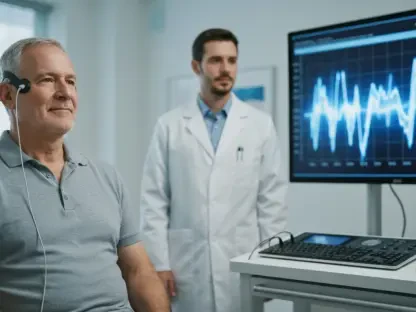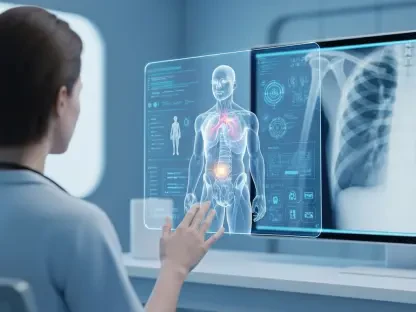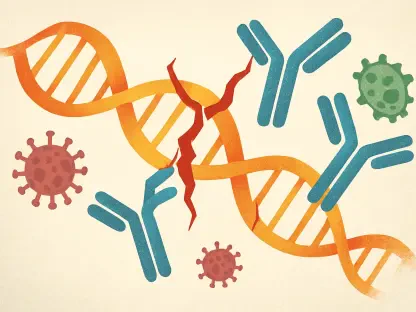Heart failure remains a formidable challenge in modern medicine, affecting millions globally and often leading to a diminished quality of life due to the heart’s inability to pump blood effectively after injury. A groundbreaking development has emerged with the U.S. Food and Drug Administration granting clearance for AD-NP1, a first-in-class monoclonal antibody, to proceed to in-human clinical trials. This marks a pivotal moment in the quest for innovative treatments targeting not just symptoms but the underlying mechanisms of tissue repair in heart failure. Developed over several years at UCLA under the guidance of Dr. Arjun Deb, director of cardiovascular research, AD-NP1 focuses on inhibiting a protein known as ENPP1, which plays a critical role in impairing recovery after heart attacks. With public funding from esteemed institutions like the National Institutes of Health and the Department of Defense, this therapy represents a unique model of medical innovation aimed at transforming patient outcomes through scientific autonomy and reduced costs.
A Novel Approach to Tissue Repair
The significance of AD-NP1 lies in its targeted mechanism, which addresses metabolic disruptions caused by ENPP1, an ectonucleotidase that degrades extracellular ATP into adenosine monophosphate. This breakdown process generates cytotoxic purines that disrupt energy balance in non-muscle cells such as fibroblasts and endothelial cells, ultimately leading to cell death and hindered tissue repair. As a result, fibrosis develops, and cardiac function deteriorates, worsening heart failure. AD-NP1 intervenes by binding to and inhibiting ENPP1, halting this harmful cascade and restoring the energy metabolism necessary for cellular growth and recovery. Dr. Deb has described this process as akin to fueling cells with the energy required to heal, highlighting how the drug enhances the body’s inherent repair mechanisms. This approach diverges sharply from traditional methods, offering a fresh perspective on how to tackle the root causes of impaired healing in heart failure patients through a precise, mechanism-based strategy.
Unlike earlier regenerative techniques such as stem cell therapies or tissue grafts, which often introduced external elements to stimulate recovery, AD-NP1 prioritizes optimizing internal repair processes by blocking a detrimental metabolic pathway. Preclinical studies conducted on mice and nonhuman primates have yielded encouraging results, demonstrating that this antibody significantly enhances heart muscle energy and contraction while reducing fibrosis. These findings suggest a notable prevention of heart failure progression, setting AD-NP1 apart as a potential game-changer in the field of cardiovascular medicine. By focusing on the body’s natural healing capacity rather than relying on external interventions, this therapy introduces a paradigm shift in regenerative approaches. The preclinical success underscores the promise of targeting specific metabolic pathways, paving the way for more effective treatments that could redefine how heart failure and related conditions are managed in clinical settings.
Clinical Trials and Future Potential
With the FDA’s approval for human trials, UCLA is poised to launch a Phase I study to evaluate the safety and efficacy of AD-NP1 in heart failure patients. This initial phase will closely monitor critical indicators such as heart function, tissue regeneration, and scar formation, alongside metabolic recovery biomarkers like orotidine, which showed elevated levels in earlier animal studies post-treatment. The primary goal is to establish a robust safety profile while gathering preliminary data on the therapeutic impact of this innovative antibody. Given the intricate nature of heart failure, where repair mechanisms often falter after acute injury, the outcomes of this study could provide invaluable insights into whether targeting ENPP1 can translate preclinical success into tangible benefits for humans. This trial represents a crucial step toward validating a treatment that could potentially alter the trajectory of care for millions affected by this debilitating condition.
Beyond the immediate focus on heart failure, the research team at UCLA envisions broader applications for AD-NP1, given the role of the ENPP1 pathway in impairing repair across various organ systems. Conditions affecting the kidneys, liver, and other tissues could potentially benefit from this therapy, as metabolic disruptions share similarities in how they obstruct healing. The prospect of extending AD-NP1’s application to other forms of organ damage highlights its versatility and underscores the importance of the upcoming clinical trials. If successful, these studies could open doors to a new class of regenerative treatments that prioritize metabolic balance as a cornerstone of recovery. Supported by public funding models from entities like the California Institute for Regenerative Medicine, this development also reflects a commitment to cost-effective innovation, offering hope for accessible therapies that address unmet needs across multiple medical domains.
Pioneering a New Era in Regenerative Medicine
Looking back, the clearance of AD-NP1 for clinical trials stood as a landmark achievement in the journey toward innovative heart failure treatments. The focus on targeting the ENPP1 protein to restore metabolic balance and bolster natural healing mechanisms marked a departure from conventional strategies, reflecting years of dedicated research at UCLA. Backed by robust preclinical evidence and a distinctive public funding approach, the therapy promised improved outcomes for patients grappling with the aftermath of heart injuries. The initiation of Phase I trials was a defining moment, setting the stage for rigorous evaluation of safety and efficacy in human subjects.
As the medical community reflected on this milestone, attention turned to the next steps, including the need for comprehensive data from clinical trials to confirm AD-NP1’s potential. Expanding research to explore its impact on other organ injuries emerged as a priority, with an emphasis on collaboration across institutions to accelerate progress. The hope was to build on this foundation, driving forward a new era of regenerative medicine where therapies are tailored to enhance the body’s innate repair capabilities, ultimately transforming patient care on a global scale.









